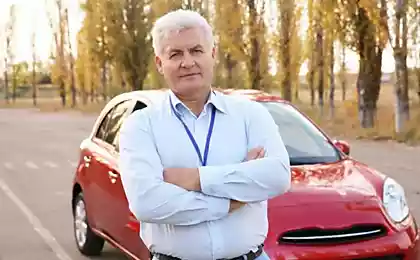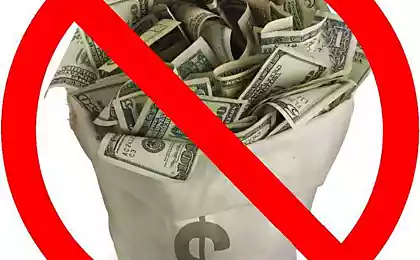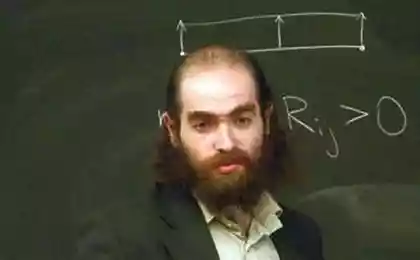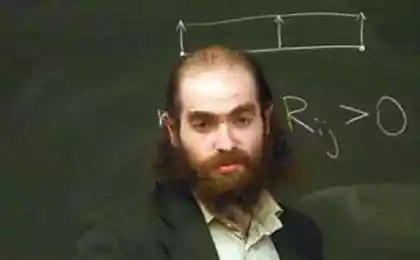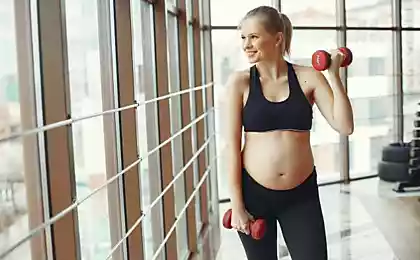729
Perelman
This man decided one of the tasks of the so-called Millennium, which beat the strongest of minds of this world. In addition, information about most of these problems. Canonizing?

The smartest man lives in St. Petersburg. As it became known on Wednesday, mathematician Grigory Perelman called a prime candidate for this title. "Izvestia" first wrote about it in 2003, when he managed to solve one of the seven millennium problems - mathematically describe the "formula of the universe." Now Perelman may receive a bonus of one million dollars.
Ceremony honoring the smartest person on the planet will take place on August 22 in Madrid after a meeting of the World Union of Mathematicians. This alliance with the support of the private Mathematics Institute in Boston has established a special medal (Fields medal) and a prize of $ 1 million for those who choose the most difficult tasks of the Millennium.
40-year-old Perelman proved the Poincaré conjecture, formulated in 1904 - sometimes also called "formula of the universe." Over more than a century it fought the greatest minds.
Perelman was born in Leningrad in the family of employees. Already in school he knew mathematics better than his teacher. "But Grisha never boasted talent. He is very modest and unpretentious man, perhaps too modest, "- speaks of him by his former teacher Tamara Efimova. Perelman has been without examinations credited to matmeh Leningrad State University.
He recently retired from the Institute. Steklov. "Many asked him to stay, but it was a hard decision," - said an employee of the Research Institute, who asked not to be named. Going back, Perelman asked his colleagues not to give any comments about it the press.
In mathematical environment abroad with respect to say about it, but sometimes referred to as "light madman" - the reason was that once Perelman refused the European Mathematical Prize. They say the jury found not qualified to judge his work.
- This is a man who is recessed into itself. Perhaps he sometimes gives the impression of a light madman. But this is not a disadvantage, but the quality inherent in all good mathematicians, - says Eugene Damaskinsky mathematician, collaborating with the Research Institute. Steklov.
According to him, Perelman is able to give up the medal and the prize. "If he would have to undergo some humiliating bureaucratic procedures, it may refuse the money. And second, whether the Russian scientist wants Perelman be in the company of those who have received this award? I do not believe that to be "the smartest man in the world" by the private American institute - is so honorable, "- says Damaskinsky.
Dobavleno1 in [mergetime] 1263739089 [/ mergetime]
7 Task 8 August 1900 in the International Congress of Mathematicians in Paris mathematician David Hilbert (David Hilbert) outlined a list of problems, which he believed to be solved in the twentieth century. The list had 23 points. Twenty one presently solved. The latest decision of the problem from a list of Gilbert was the famous Fermat's last theorem, which the scientists could not cope for 358 years. In 1994, the decision suggested the Briton Andrew Wiles. It turned out to be true.
Following the example of Gilbert's at the end of the last century, many mathematicians tried to formulate such strategic objectives for the twenty-first century. One of these lists is widely known for the Boston billionaire Landon Clay (Landon T. Clay). In 1998, at his expense in Cambridge (Massachusetts, USA) was based Clay Mathematics Institute (Clay Mathematics Institute), and set bonuses for a number of important issues of modern mathematics. May 24, 2000, experts of the Institute chose seven issues - the number of millions of dollars allocated for bonuses. List called Millennium Prize Problems:
1. Problem Cook (formulated in 1971)
Assume that you are in a large company, you want to make sure that there is someone you know. If you say that he's sitting in the corner, it will be enough of a second, so that a glance, ensure the validity of the information. In the absence of this information, you will have to get around the room, examining room. It says that the solution to a problem often takes longer than the validation solutions.
Steven Cook stated the problem: whether validation solution of the problem to be longer than the actual receipt of the decision, irrespective of the verification algorithm. This problem is also one of the unsolved problems of logic and science. Its decision could revolutionize the basics of cryptography used in the transmission and storage of data.
2. Riemann hypothesis (formulated in 1859)
Some integers can not be expressed as the product of two smaller integers, such as 2, 3, 5, 7, and so on. Such numbers are called simple and play an important role in pure mathematics and its applications. The distribution of prime numbers among all the series of natural numbers is not subject to any law. However, the German mathematician Riemann suggested concerning the properties of the sequence of prime numbers. If the Riemann hypothesis is proved, it will lead to a revolutionary change in our knowledge of encryption and unprecedented breakthrough in the field of Internet security.
3. The hypothesis of Birch and Swinnerton-Dyer (formulated in 1960)
Related to the description of the set of solutions of certain algebraic equations in several variables with integer coefficients. An example of this is the expression of the equation x2 + y2 = z2. Euclid gave a complete description of the solutions of this equation, but for more complex equations of finding solutions becomes extremely difficult.
4. Hodge conjecture (formulated in 1941)
In the twentieth century mathematicians discovered a powerful method for studying the shape of complex objects. The basic idea is to use the object itself instead of simple "building blocks" that are glued together to form his likeness. Hodge conjecture involves some assumptions about the properties of these "bricks" and objects.
5. The Navier - Stokes (formulated in 1822)
If you swim in a boat on the lake, the waves arise, and if you fly on a plane, in the air encounter turbulence. It is assumed that these and other phenomena described by equations, known as the Navier - Stokes equations. The solutions to these equations are not known, and thus do not even know how to solve them. It is necessary to show that a solution exists and is sufficiently smooth function. Solving this problem will significantly change the way of hydro and aerodynamic calculations.
6. The problem of Poincare (formulated in 1904)
If you pull a rubber band at the apple, you can slowly moving the tape without interruption from the surface, to compress it to a point. On the other hand, if the same rubber tape properly tighten around the donut, it is not possible in any way to compress the tape to a point without tearing the tape without breaking or bagel. It is said that Apple is simply connected surface, and the surface of the donut - no. Prove that is simply connected only to the scope, it was so hard, that mathematicians are looking for the right answer so far.
7. Yang - Mills (formulated in 1954)
The equations of quantum physics describes the world of elementary particles. Physicists Yang and Mills, found a link between geometry and physics of elementary particles, wrote his equations. Thus, they found a way to unite the theories of electromagnetic, weak and strong interactions. Because of the Yang - Mills should the existence of particles that have indeed been observed in laboratories around the world, so the Yang - Mills theory accepted by most physicists, despite the fact that this theory is still not possible to predict the masses of elementary particles.
All.
Source:

The smartest man lives in St. Petersburg. As it became known on Wednesday, mathematician Grigory Perelman called a prime candidate for this title. "Izvestia" first wrote about it in 2003, when he managed to solve one of the seven millennium problems - mathematically describe the "formula of the universe." Now Perelman may receive a bonus of one million dollars.
Ceremony honoring the smartest person on the planet will take place on August 22 in Madrid after a meeting of the World Union of Mathematicians. This alliance with the support of the private Mathematics Institute in Boston has established a special medal (Fields medal) and a prize of $ 1 million for those who choose the most difficult tasks of the Millennium.
40-year-old Perelman proved the Poincaré conjecture, formulated in 1904 - sometimes also called "formula of the universe." Over more than a century it fought the greatest minds.
Perelman was born in Leningrad in the family of employees. Already in school he knew mathematics better than his teacher. "But Grisha never boasted talent. He is very modest and unpretentious man, perhaps too modest, "- speaks of him by his former teacher Tamara Efimova. Perelman has been without examinations credited to matmeh Leningrad State University.
He recently retired from the Institute. Steklov. "Many asked him to stay, but it was a hard decision," - said an employee of the Research Institute, who asked not to be named. Going back, Perelman asked his colleagues not to give any comments about it the press.
In mathematical environment abroad with respect to say about it, but sometimes referred to as "light madman" - the reason was that once Perelman refused the European Mathematical Prize. They say the jury found not qualified to judge his work.
- This is a man who is recessed into itself. Perhaps he sometimes gives the impression of a light madman. But this is not a disadvantage, but the quality inherent in all good mathematicians, - says Eugene Damaskinsky mathematician, collaborating with the Research Institute. Steklov.
According to him, Perelman is able to give up the medal and the prize. "If he would have to undergo some humiliating bureaucratic procedures, it may refuse the money. And second, whether the Russian scientist wants Perelman be in the company of those who have received this award? I do not believe that to be "the smartest man in the world" by the private American institute - is so honorable, "- says Damaskinsky.
Dobavleno1 in [mergetime] 1263739089 [/ mergetime]
7 Task 8 August 1900 in the International Congress of Mathematicians in Paris mathematician David Hilbert (David Hilbert) outlined a list of problems, which he believed to be solved in the twentieth century. The list had 23 points. Twenty one presently solved. The latest decision of the problem from a list of Gilbert was the famous Fermat's last theorem, which the scientists could not cope for 358 years. In 1994, the decision suggested the Briton Andrew Wiles. It turned out to be true.
Following the example of Gilbert's at the end of the last century, many mathematicians tried to formulate such strategic objectives for the twenty-first century. One of these lists is widely known for the Boston billionaire Landon Clay (Landon T. Clay). In 1998, at his expense in Cambridge (Massachusetts, USA) was based Clay Mathematics Institute (Clay Mathematics Institute), and set bonuses for a number of important issues of modern mathematics. May 24, 2000, experts of the Institute chose seven issues - the number of millions of dollars allocated for bonuses. List called Millennium Prize Problems:
1. Problem Cook (formulated in 1971)
Assume that you are in a large company, you want to make sure that there is someone you know. If you say that he's sitting in the corner, it will be enough of a second, so that a glance, ensure the validity of the information. In the absence of this information, you will have to get around the room, examining room. It says that the solution to a problem often takes longer than the validation solutions.
Steven Cook stated the problem: whether validation solution of the problem to be longer than the actual receipt of the decision, irrespective of the verification algorithm. This problem is also one of the unsolved problems of logic and science. Its decision could revolutionize the basics of cryptography used in the transmission and storage of data.
2. Riemann hypothesis (formulated in 1859)
Some integers can not be expressed as the product of two smaller integers, such as 2, 3, 5, 7, and so on. Such numbers are called simple and play an important role in pure mathematics and its applications. The distribution of prime numbers among all the series of natural numbers is not subject to any law. However, the German mathematician Riemann suggested concerning the properties of the sequence of prime numbers. If the Riemann hypothesis is proved, it will lead to a revolutionary change in our knowledge of encryption and unprecedented breakthrough in the field of Internet security.
3. The hypothesis of Birch and Swinnerton-Dyer (formulated in 1960)
Related to the description of the set of solutions of certain algebraic equations in several variables with integer coefficients. An example of this is the expression of the equation x2 + y2 = z2. Euclid gave a complete description of the solutions of this equation, but for more complex equations of finding solutions becomes extremely difficult.
4. Hodge conjecture (formulated in 1941)
In the twentieth century mathematicians discovered a powerful method for studying the shape of complex objects. The basic idea is to use the object itself instead of simple "building blocks" that are glued together to form his likeness. Hodge conjecture involves some assumptions about the properties of these "bricks" and objects.
5. The Navier - Stokes (formulated in 1822)
If you swim in a boat on the lake, the waves arise, and if you fly on a plane, in the air encounter turbulence. It is assumed that these and other phenomena described by equations, known as the Navier - Stokes equations. The solutions to these equations are not known, and thus do not even know how to solve them. It is necessary to show that a solution exists and is sufficiently smooth function. Solving this problem will significantly change the way of hydro and aerodynamic calculations.
6. The problem of Poincare (formulated in 1904)
If you pull a rubber band at the apple, you can slowly moving the tape without interruption from the surface, to compress it to a point. On the other hand, if the same rubber tape properly tighten around the donut, it is not possible in any way to compress the tape to a point without tearing the tape without breaking or bagel. It is said that Apple is simply connected surface, and the surface of the donut - no. Prove that is simply connected only to the scope, it was so hard, that mathematicians are looking for the right answer so far.
7. Yang - Mills (formulated in 1954)
The equations of quantum physics describes the world of elementary particles. Physicists Yang and Mills, found a link between geometry and physics of elementary particles, wrote his equations. Thus, they found a way to unite the theories of electromagnetic, weak and strong interactions. Because of the Yang - Mills should the existence of particles that have indeed been observed in laboratories around the world, so the Yang - Mills theory accepted by most physicists, despite the fact that this theory is still not possible to predict the masses of elementary particles.
All.
Source:





